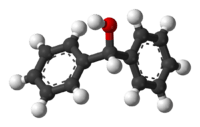Diphenylmethanol
 | |
 | |
| Names | |
|---|---|
| IUPAC name
Diphenylmethanol | |
| Other names
Benzhydrol Diphenylcarbinol Hydroxydiphenylmethane | |
| Identifiers | |
| 91-01-0 | |
| ChemSpider | 6770 |
| |
| Jmol-3D images | Image |
| PubChem | 7037 |
| |
| Properties | |
| Molecular formula |
C13H12O |
| Molar mass | 184.23 g·mol−1 |
| Appearance | White crystals |
| Density | 1.103 g/cm3 |
| Melting point | 69 °C (156 °F; 342 K) |
| Boiling point | 298 °C (568 °F; 571 K) |
| 0.5 g/L (20 °C) | |
| Hazards | |
| R-phrases | R36 R37 R38 |
| S-phrases | S26 S27 S28 S29 S30 S33 S35 S36 |
| Related compounds | |
| Related compounds |
Benzophenone |
| Except where noted otherwise, data is given for materials in their standard state (at 25 °C (77 °F), 100 kPa) | |
| | |
| Infobox references | |
Diphenylmethanol, (C6H5)2CHOH (also known as benzhydrol), is a secondary alcohol with a relative molecular mass of 184.23 g/mol. It has a melting point of 69 °C and a boiling point of 298 °C.
It has uses in perfume and pharmaceutical manufacture. In pharmaceutical manufacture it is used as a fundamental component in antihistamines, antihypertensive agents and antiallergenic agents. Benzhydrol is used as an intermediate of pharmaceuticals (including antihistamines), agrochemicals, and other organic compounds. It is also used as a fixative in perfumery and as a terminating group in polymerizations. Benzhydryl is a skeleton for Histamine H1 antagonist which an ethylamine group is attached to a diphenylmethane structure.
Diphenylmethanol is an irritant to the eyes, skin and respiratory system.
Preparation
Diphenylmethanol may be prepared by a Grignard reaction between phenylmagnesium bromide and benzaldehyde, or by reducing benzophenone, with sodium borohydride or with zinc dust or with sodium amalgam and water.[2]
References
- ↑ MSDS
- ↑ F. Y. Wiselogle and H. Sonneborn, III (1941). "Benzohydrol". Org. Synth.; Coll. Vol. 1, p. 90